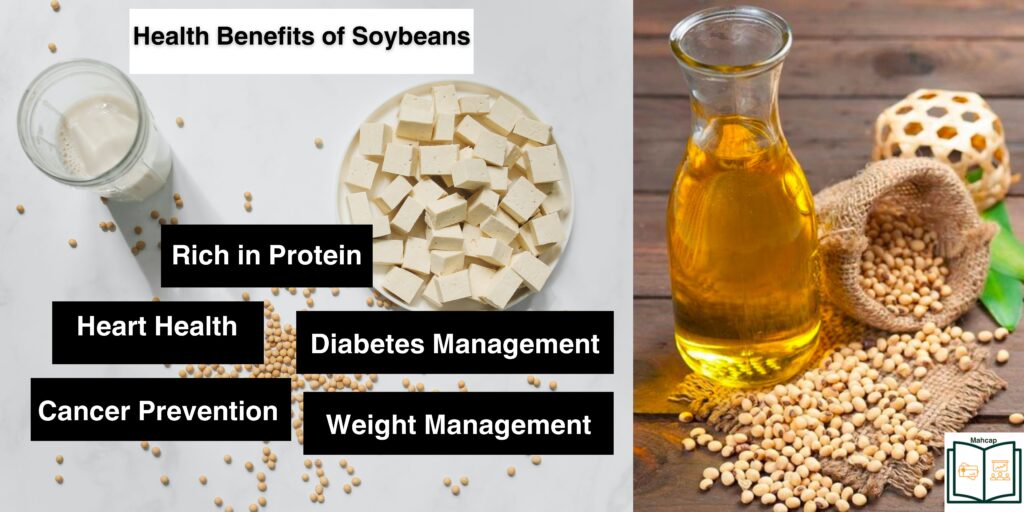Health Benefits and Uses of Soybeans
Soybean (Glycine max) is one of the most valuable crops in the world due to its multiple uses. It is a source of protein and oil for humans, feed for livestock and aquaculture, and biofuel. Consumption of soy foods is increasing worldwide mainly due to their acclaimed heart-health benefits.
Soybean belongs to the Legume or Pea family and is the most feasible legume in the prevailing climate in Africa. It is one of the tropical legume crops that have shown sustained growth in all the production parameters, including cultivated area, yield and production over the past decades. Hence, it is regarded as the Cinderella crop of Africa1.
Soybean Cultivation in Africa
Increasing global food demand due to population growth has led to crop diversification and adaptation strategies in many continents. Globally, America, Brazil, Argentina, China, and India are the largest producers of soybeans due to its numerous benefits2.
Soybeans are a non-native and non-stable crop in Africa introduced to the continent by Chinese traders in the 19th century. It was first cultivated in Africa as an economic crop in South Africa in 1903. Tanzania (1907), Nigeria (1908), Malawi (1909), and Sudan (1910) joined South Africa a few years later in the cultivation of soybeans. Soybean cultivation is regarded as an adaptative and mitigation strategy amidst climate change impacts, the malnutrition crisis, and farmers’ vulnerability.

South Africa is leading in producing soybeans, followed by Nigeria, Zambia, and Uganda. The increasing demand for soybeans for different purposes in Africa increased the land for cultivation to 1.5 million hectares in 2016(3).
Soybean Consumption and Uses
About 20% of soybeans are oil, and 40% are protein, making them highly demanding for human nutrition, animal feed, and industrial uses(2).
Food
Soybeans are consumed as food in different ways.
Cooking oil
Soy oil is now commonly used for cooking and food production.
Soymilk
Soymilk is tasty and nutritious. It is produced by soaking dried soybeans in water, blending them with fresh water, and then straining out the solids to create a smooth, creamy liquid. Sweeteners, flavourings, or fortifications with vitamins and minerals may be added. Soy milk is a popular choice for individuals who are lactose intolerant, allergic to dairy, or following a vegan or plant-based diet.
Soy yogurt
Soy yogurt, or soygurt, is a dairy-free alternative to traditional yogurt made from soy milk. It is produced through a fermentation process and has a creamy texture similar to dairy yogurt.
Soy porridge
Soy porridge is a nutritious and delicious dish made from soybeans. It is prepared by cooking soybean flour with water or milk until it becomes soft and tender. It is a recommended food for malnourished children and HIV/AIDS-infected patients3.
Soy kebab (spicy tofu)
Soy kebab is a vegan alternative to traditional meat kebabs, typically made from soy protein. They are mixed with various seasonings, herbs, and spices to mimic the flavour and texture of meat.

Dawadawa
The earliest known use of soy-based food in rural Nigeria was in the form of dawadawa, a fermented soup condiment traditionally made from locust bean seeds. Presently, most of the dawadawa produced in Nigeria uses soybean as its raw material. Dawadawa is consumed in Northern Ghana as well to add flavour to soups.
Soy Sauce
Soy sauce is commonly used as a seasoning and flavour enhancer in various dishes, including stir-fries, marinades, sauces, soups, and dipping sauces. It is made from fermented soybeans, wheat, salt, and sometimes other grains or ingredients.
Animal Feed
After extracting oil, the remaining meal is a valuable protein source used in animal feed for livestock and poultry.
Industrial uses
Soybean manufactures various products, including cosmetics, medications, paints, soaps, and lubricants.
Nutrition and Health Benefits of Soybeans
Soybeans offer a variety of health benefits due to their nutritional content. Here are some key advantages:
Rich in Protein
Soybeans are an excellent plant-based source of protein, making them essential for children and pregnant women. For instance, in Zaire, now the Democratic Republic of Congo, and Southwest Sudan, soybeans were cultivated as medicinal food crops to prevent and cure malnutrition among infants, children, pregnant women, and lactating mothers4.
Heart Health
Consuming soybeans may contribute to heart health. In 1999, the US FDA permitted food manufacturers to label products high in soy protein, indicating that these foods may help lower the risk of heart disease. Studies confirmed the argument provided by the American Heart Association (AHA) that soy food intake promotes heart health5.
Cancer Prevention
In an extensive review of over 150 studies with emphasis on those involving women, it was shown that soy intake is associated with a third reduction in the risk of breast cancer in women. Soybeans have antioxidant properties that may help reduce the risk of certain cancers, including breast and prostate cancer(2).

Diabetes Management
Soybeans are a good option for individuals with diabetes, as they can contribute to managing blood sugar levels. Evidence from studies showed that fermented soy products may be better for preventing or delaying the progression of type 2 diabetes. Also, the incidence of type 2 diabetes has been lower in Asian populations compared with those in Western countries due to the consumption of fermented soybean products(5).
Weight Management
Soy protein is clinically proven to lower cholesterol and might have added benefits for glucose regulation. Also, scientific evidence shows that soy protein is a good weight loss and management option(1).
Soybean products are a great source of plant protein and, therefore, good for human health. However, it might have some side effects for those allergic to soybeans foods.
Subscribe to Mahcap for more insightful information on Africa and food health.
By: Huzeima Mahamadu (Researcher and Storyteller) And Ayisha Gunu Mohammed (Agric Biotechnology graduate and researcher in Soybeans)
References
- Siamabele, B. (2021). The significance of soybean production in the face of changing climates in Africa. Cogent Food & Agriculture, 7(1), 1933745. https://doi.org/10.1080/23311932.2021.1933745
↩︎ - Kwon, D. Y., Daily, J. W., Kim, H. J., & Park, S. (2010). Antidiabetic effects of fermented soybean products on type 2 diabetes. Nutrition Research, 30(1), 1–13. https://doi.org/10.1016/j.nutres.2009.11.004
↩︎ - Bosman, M. J. C., Ellis, S. M., Bouwer, S. C., Jerling, J. C., Erasmus, A. C., Harmse, N., & Badham, J. (2009). South African consumers’ opinions and consumption of soy and soy products. International Journal of Consumer Studies, 33(4), 425–435. https://doi.org/10.1111/j.1470-6431.2009.00782.x
↩︎ - Lokuruka, M. (2010). Soybean nutritional properties: The good and the bad about soy foods consumption – A review. African Journal of Food, Agriculture, Nutrition and Development, 10(4). https://doi.org/10.4314/ajfand.v10i4.55335
↩︎ - Kwon, D. Y., Daily, J. W., Kim, H. J., & Park, S. (2010). Antidiabetic effects of fermented soybean products on type 2 diabetes. Nutrition Research, 30(1), 1–13. https://doi.org/10.1016/j.nutres.2009.11.004
↩︎
